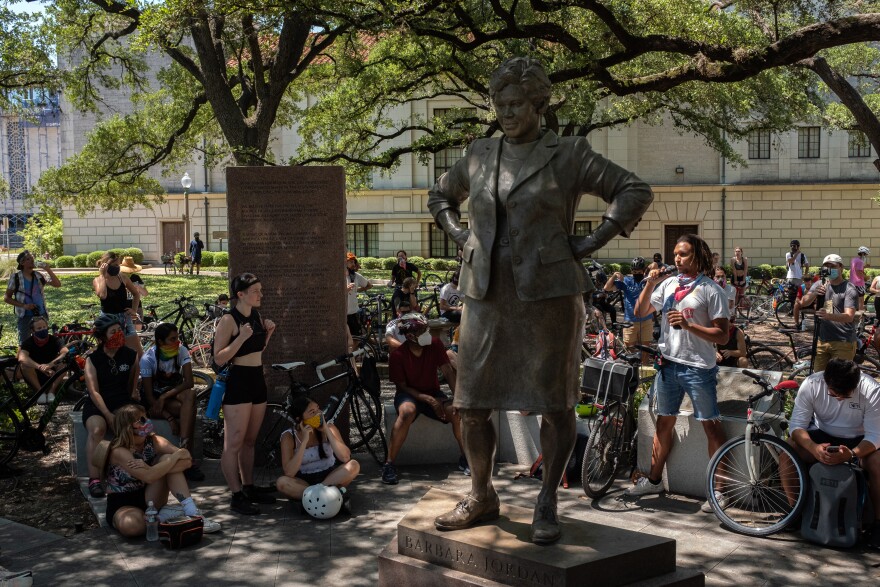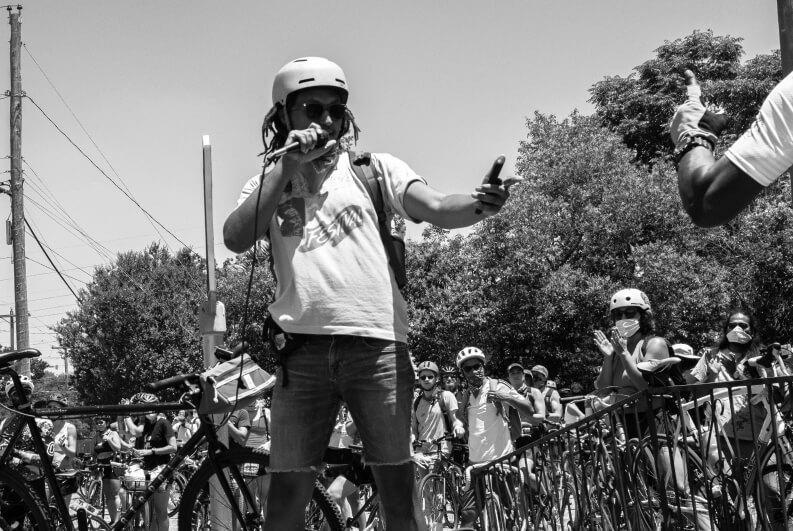KUT 90.5 | By Nadia Hamdan |Published July 24, 2020 at 7:01 AM CDT
When Talib Abdullahi first shared his idea on Instagram, he wasn’t expecting much.
He wanted to get some friends together for a bike ride to explore Austin’s Black history. He figured maybe 20 or 30 friends would join him.
But that’s not what happened.
In the span of a few hours, a screenshot of his Instagram story was making its way across social media. Over the course of the next few days, Facebook groups were created, posters were designed and sponsors were booked.
“It just snowballed,” he said.
By the end of the week, Abdullahi found himself standing in front of roughly 400 face-masked cyclists – all looking to him to teach them about this often overlooked part of Austin’s history.
What started as a simple bike ride with friends soon turned into a grassroots-led initiative bringing together people from all across the community. The event was so successful, he decided to make a self-guided tour available online. And now community organizers in other cities are looking to create their own.
The Idea
Now, Abdullahi is not a historian. He’s an event coordinator for Tito’s Handmade Vodka. So, you may be wondering: how did he find himself commanding the attention of hundreds of people and … why are they all on bikes?
Well, his idea came on the heels of the protest at Huston-Tillotson University in East Austin on June 7. Abdullahi was one of the thousands of people who showed up demanding an end to police violence and systemic racism. The gathering was by far the largest protest out of the nearly dozen that had taken place in Austin over two weeks, sparked by the police killing of George Floyd.
When Abdullahi got home that night, he felt compelled to do something. After days of anger and frustration, he was looking to put together an event that would not only honor the moment but would help alleviate some of the anxieties he’d seen building around him.
“Why don’t we create a space where people are channeling that energy in a way that is a little bit more positive, a little kinder to each other,” he said, “and use that as a learning experience.”
Abdullahi opened Google Maps.
He started putting together a bike route to 12 different sites across the city that showcase local Black history. The route was 8.46 miles to honor George Floyd, who was killed in May after a Minneapolis police officer held his knee on Floyd’s neck for eight minutes and 46 seconds.
Austin Black History Social Ride
Abdullahi, who has a passion for both cycling and history, thought this would be a good way to sustain the momentum of the last two weeks.
“Local history isn’t really discussed in elementary schools or middle schools,” he said. “If anything, I would hope to be giving people tools to learn this history themselves and give them an opportunity to understand their own city a little bit better.”
“If anything, I would hope to be giving people tools to learn this history themselves and give them an opportunity to understand their own city a little bit better.”
The next morning he posted the idea on his Instagram story and put out a call to his friends inviting them all to join him for what he dubbed a “Black History Social Ride.”
It took off.
He started to see a screenshot of his invitation shared all over Instagram, then Facebook. Even some local bike shops were sharing the event online.
His friends rallied behind him and within the week they had a whole team of volunteers donating their time.
Cyclists from different clubs offered to help keep the riders safe and hydrated on the road. A coffee shop donated free cold brew. Pedicabbers promised to be there for people who were not able to ride bikes.
“There was just a huge outpouring from the community,” he said. “It was really heartwarming.”
Austin Showed Up
On Sunday, June 14, exactly one week after the protest at Huston-Tillotson, Abdullahi and his team of volunteers made their way to the front gates of the Texas Capitol. He’d decided to start the tour there to talk about the Texas African American History Memorial located on the grounds.
He got there early and waited to see just how many people would actually show up.
Bikes started rolling in – and didn’t stop.

Soon there was a sea of masked cyclists crowding both lanes of 11th Street, to the point that volunteers had to start directing them down the sides of the sidewalks so cars could pass.
Donald Davis is a founding member of the Major Taylor Cycling Club of Austin, made up of majority Black cyclists. The club’s namesake honors Major Taylor, the first Black man to win a cycling world championship in 1899 and the second Black man to win a world championship in any sport.
“It almost didn’t matter how many people showed up. It was just that people wanted to be there.”
Davis was there with his fellow club members donating their time to make sure everything ran smoothly during the tour. He said it was remarkable to see people from all different backgrounds show up for this ride.
“I’ve been here since ‘91,” he said. “I don’t think I’ve ever seen that kind of brotherhood and sisterhood except for, like, an MLK March.”
Abdullahi is not usually the man with the bullhorn and says he doesn’t necessarily enjoy public speaking in front of large crowds. But he felt inspired that so many people turned out with the intention to learn.
“It almost didn’t matter how many people showed up,” he said. “It was just that people wanted to be there.”
From the seat of his bike, Abdullahi began telling stories about the Black experience. When he spoke, the cyclists were quiet – save the occasional ringing of bicycle bells.
The History Of Clarksville
The riders moved like a hive, buzzing with energy as they made their way through the streets of the city to reach the next stop.
One of those stops included the Haskell House in Clarksville. Mary Reed, president of the Clarksville Community Development Corporation, was there to give the history of the house and the surrounding neighborhood.
“Clarksville is a special place. [It] should be preserved and the history respected. [I felt like] finally people were starting to understand that and appreciate it.”
“Clarksville is a special place,” she said. “[It] should be preserved and the history respected. [I felt like] finally people were starting to understand that and appreciate it.”
Clarksville, founded in 1871 by freedman Charles Clark, became a settlement for formerly enslaved people in a small area of West Austin. By the early 20th century, developers in Austin began to see the value of the land and started pressuring the Black community there to move into the so-called “Negro district” established by the city’s 1928 Master Plan.
City officials were able to drive nearly all the Black families out of Clarksville by denying them basic public services and shutting down the local school. Today, the neighborhood is mostly made up of white families.
“If you’d have asked me, ‘What do you think of Clarksville?’ my first words would be, ‘a hip, yuppy neighborhood that I’ll likely never afford to live in,’” said 29-year-old Hannah Vaugh, a teacher at Bedichek Middle School, who attended the ride. “That will never be my free association again.”
Vaugh said learning the history of Clarksville and being able to visualize the community that once lived there completely changed the way she looks at the West Austin neighborhood. She said she grew up in this city, but, as a white woman, she was unaware of a lot of it’s racial past until she went on Abdullahi’s bike ride.
“It’s a good invitation to be less naive,” she said. “Acknowledging that I’m complicit in my own lack of self-education.”
Abdullahi said this is a big reason he felt compelled to teach people not just Black history – but Austin’s Black history.
“It’s been said so many times, but history really does repeat itself if you fail to remember it,” he said. “A lot of these things that we’re seeing happening now, like the gentrification of East Austin, is directly correlated to the forced migration of people from Clarksville.”
The tour stopped at a total of 12 sites across Austin including the Reverend Jacob Fontaine Gold Dollar Building in Wheatville, the Oakwood Cemetery and Huston-Tillotson University.

Jimena Gamboa Bonilla, 25, was another rider who took the tour. She said Austin’s history is often presented as a one-sided, whitewashed narrative.
“At one point it stops being a lack of awareness,” she said, “and starts being willingly ignorant.”
But she said this ride changed something for her. The day was hot and the hills merciless. And still hundreds of people were pumping their legs and sweating their way to the next stop … and the next stop … and the next stop.
“It was beautiful. It made me realize, ‘Wow, there are 400 other humans here that are willing to ride in the middle of the summer,” she said. “It kind of gave me more hope that, in Austin, there are people that care.”
Share The Route
Due to the coronavirus pandemic, Abdullahi says all the Austin Black History Social Rides since that Sunday have been much smaller to ensure social distancing. He’s also shared the entire route on social media so people can take a self-guided tour.
After seeing the turn out in Austin, residents of other cities, like Houston, Tulsa and Detroit, are making plans to create Black history social rides of their own. Abdullahi is currently reaching out to organizations within those cities to see what’s possible.
But, he says, his ambitions are very simple: He just hopes to inspire more people to get out into their own communities and learn about the Black, Latino and Indigenous stories that exist all around them.
“If we can create avenues for people to do that,” he says, “that’s a win in my book.”


